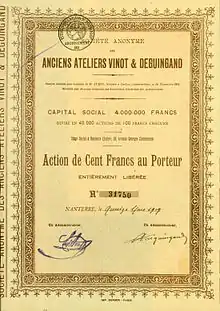 | |
 | |
| Industry | Manufacturing |
|---|---|
| Founded | 1898 (as a bicycle manufacturer) 1901 (first automobile) |
| Defunct | 1926 |
| Headquarters | , |
| Products | Automobiles |
Vinot-Deguingand was a French automobile producer.[1] [2][3]

History
In 1898 Lucien-Marie Vinot-Préfontaine (1858–1915) and Albert Deguingand (1872–1943) founded the business at Puteaux for the manufacture of bicycles. Motor car production began in 1901.
Sources vary about the format of the name - Vinot & Deguingand, Vinot-Deguingand[4][5] or, from 1907, Vinot.[1]
In 1906[2] or 1909[4] Vinot acquired Gladiator and until 1920 two virtually identical ranges were offered with the Vinot and the Gladiator names.[4]
The company also owned a London based subsidiary called "Vinot Cars Ltd" which often provided for Vinots to have their bodywork fitted by locally based English coach-builders.[5] The early cars sold in England were sold under the name "La Silencieuse".[4]
After the war manufacturing activity was transferred to newly acquired premises at Nanterre on the west of Paris. However, production ended in 1926 in response to a falling away in customer demand. The factory was sold to Donnet-Zédel. It was later sold to Henri Pigozzi and became the principal production location for Simca-Fiat (subsequently Simca)
Lucien-Marie Vinot-Préfontaine having died in 1915, Albert Deguingand in 1927 founded another auto-maker, named Société des Nouveaux Ateliers A. Deguingand, which would last till 1929 or 1930.
Automobiles
The first car had a twin-cylinder 1500cc engine and chain drive. In 1903 the twin cylinder model was designated as the manufacturer's "10CV" model, and was joined by a four cylinder 3300cc "H14CV" and a "F18CV". The 5800cc "30CV" followed in 1905, joined in 1906 by the manufacturer's first six-cylinder car.
The range for 1908 comprised a "10/14CV" and a "16/24CV". A "24CV" with a 4-litre engine was added in 1910. The range in 1914 involved cars with engine sizes of 1700cc, 2100cc, 2600cc and 4200cc.
Less than a year following the outbreak of peace, in October 1919 the manufacturer took a stand at the 15th Paris Motor Show and exhibited the 12CV Vinot-Deguignand Type BO, which sat on a 3,030 mm (119.3 in) wheelbase and was powered by a 4-cylinder engine of 2603cc.[5]
Competition
A team from Vinot & Deguingand took part in the inaugural 1923 Le Mans 24 Hour race. The brothers Léon and Lucien Molon completed 77 laps in a 10HP Vinot & Deguingand Type BP. This total was 51 laps behind the race leader and sufficient for 26th place overall and 6th place in the 2.0 classification.[6][7]
Reading list
- Harald Linz, Halwart Schrader: Die Internationale Automobil-Enzyklopädie. United Soft Media Verlag, München 2008, ISBN 978-3-8032-9876-8. (German)
- George Nick Georgano (Chefredakteur): The Beaulieu Encyclopedia of the Automobile. Volume 3: P–Z. Fitzroy Dearborn Publishers, Chicago 2001, ISBN 1-57958-293-1. (English)
- George Nick Georgano: Autos. Encyclopédie complète. 1885 à nos jours. Courtille, Paris 1975. (French)
Sources and notes
- 1 2 Linz, Schrader: Die Internationale Automobil-Enzyklopädie.
- 1 2 Georgano: The Beaulieu Encyclopedia of the Automobile.
- ↑ Georgano: Autos. Encyclopédie complète. 1885 à nos jours.
- 1 2 3 4 Georgano, Nick (1968). The Complete Encyclopaedia of Motorcars 1885-1968. London: George Rainbird Ltd for Ebury Press Limited. pp. 586–587.
- 1 2 3 "Automobilia". Toutes les voitures françaises 1920 (salon [Paris, Oct] 1919). Paris: Histoire & collections. Nr. 31: Page 81. 2004.
- ↑ "Le Mans 24 Hours 1923 - Race Results - Racing Sports Cars". www.racingsportscars.com. Retrieved 2018-02-12.
- ↑ Spurring, Quentin. Le Mans, 1923-29: the official history of the world's greatest motor race. Sherborne, Dorset, UK. pp. 42, 86. ISBN 9781910505083. OCLC 951812820.